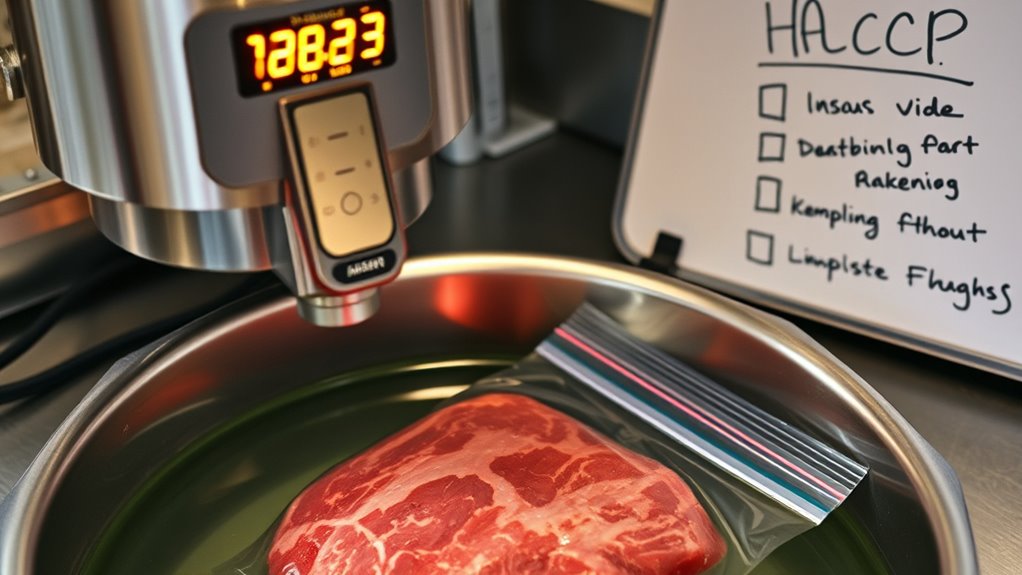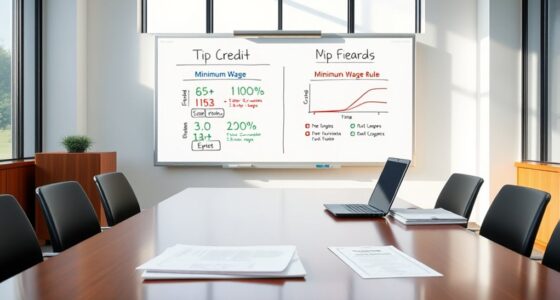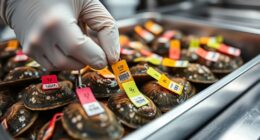To guarantee safe sous vide cooking, you need to maintain precise temperatures for specific times to destroy harmful bacteria like Salmonella and E. coli. Proper calibration of your device, monitoring, and following trusted time-temperature guidelines are essential for safety and quality. Incorporate HACCP principles by identifying critical control points and verifying temperatures regularly. Correct handling, storage, and reheating also play important roles. Keep safety in mind at every step—more detailed tips can help you perfect your process.
Key Takeaways
- Maintain precise temperature control to ensure safe pathogen reduction and prevent bacterial growth during sous vide cooking.
- Regularly calibrate and monitor immersion circulators to ensure accurate and consistent temperature maintenance.
- Follow trusted time-temperature guidelines to effectively neutralize pathogens like Salmonella, Listeria, and E. coli.
- Integrate HACCP principles by identifying critical control points, such as sealing and cross-contamination prevention.
- Properly chill and store cooked food below 40°F, and reheat thoroughly to prevent bacterial re-growth post-cooking.

Are you confident that your sous vide cooking is both delicious and safe? Ensuring safety starts with understanding how precise temperature control plays a critical role in reducing health risks. When you set your immersion circulator, you’re not just aiming for perfectly cooked food — you’re actively controlling the temperature to create an environment that minimizes the growth of harmful bacteria. This method, known as pathogen reduction, relies on maintaining specific temperatures for designated periods, effectively destroying dangerous microorganisms like Salmonella, Listeria, and E. coli. By staying within recommended temperature ranges, you can cook meats, seafood, and vegetables safely without sacrificing quality or flavor.
Maintaining precise temperature control ensures safe, pathogen-free sous vide meals without sacrificing flavor.
Temperature control isn’t just about hitting the right numbers; it’s about maintaining them consistently throughout the cooking process. When you set your sous vide cooker, ensure it’s calibrated properly and monitor it periodically. Fluctuations can compromise pathogen reduction efforts, leaving your food vulnerable to contamination. Using a reliable, accurate device helps guarantee that the internal temperature of your food reaches the safe zone and stays there long enough to eliminate pathogens. This is especially important when cooking tougher cuts or large pieces, where longer cooking times are necessary for safety. Remember, some bacteria are more resistant and require higher temperatures or extended cooking periods to be effectively neutralized.
Incorporating the principles of HACCP (Hazard Analysis and Critical Control Points) into your sous vide routine helps you identify and control safety risks. Critical control points include setting the correct time and temperature, ensuring proper vacuum sealing, and avoiding cross-contamination. For example, if you’re cooking chicken, maintaining a temperature of at least 140°F (60°C) for a specific duration will markedly reduce the risk of foodborne illness. Always verify the recommended time-temperature combinations from trusted sources or guidelines, and adhere to them strictly. Using a food thermometer to double-check internal temperatures before serving adds an extra layer of assurance. Proper air circulation around your sous vide setup can also help maintain stable temperatures and prevent hot spots.
Also, be mindful of post-cooking handling. Once your food reaches the target temperature and has been held there long enough, proper chilling and storage are essential to prevent bacteria from re-growing. If you plan to hold food after cooking, keep it below 40°F (4°C), or reheat it thoroughly before serving. By combining diligent temperature control, adherence to time guidelines, and good hygiene practices, you’re implementing a thorough safety approach rooted in HACCP principles. This way, you can enjoy your sous vide creations with confidence, knowing they’re both delicious and safe to eat.
Frequently Asked Questions
How Do I Prevent Cross-Contamination When Using Sous Vide?
To prevent cross-contamination when using sous vide, you should practice proper sanitation by thoroughly cleaning all equipment and utensils before and after use. Keep raw meats separate from cooked foods, and use different vacuum bags for different ingredients. Store ingredients at proper temperatures, and handle them with clean hands or gloves. Regular equipment cleaning guarantees bacteria don’t transfer between items, keeping your sous vide process safe and hygienic.
Are There Specific Storage Guidelines for Sous Vide Cooked Foods?
Follow proper storage guidelines for sous vide cooked foods by promptly refrigerating or freezing them after cooking. Keep your foods at or below 40°F (4°C) in airtight containers to prevent bacterial growth, and avoid leaving cooked items out at room temperature for extended periods. Use refrigeration practices that prioritize quick cooling and consistent temperature control to ensure safety, freshness, and quality. Always label stored foods with date and contents for easy management.
Can Sous Vide Be Used Safely With All Types of Meats?
Yes, you can safely use sous vide with most meat varieties, but you need to pay attention to cooking temperatures and times for each type. For example, poultry requires higher temperatures to guarantee safety, while beef and pork can be cooked at lower temps for tenderness. Always follow recommended guidelines to effectively eliminate pathogens and ensure your meats are safe to eat. Proper temperature control is key to safe sous vide cooking.
What Are the Signs of Bacterial Growth in Sous Vide Foods?
You should look for bacterial indicators like a foul smell, slimy texture, or unusual discoloration as signs of bacterial growth in your sous vide foods. Spoilage signs also include bubbles or foam in the bag, off-odor, or a sticky surface. If you notice any of these signs, it’s safest to discard the food, as bacterial growth can cause illness even if it’s not visible. Always trust your senses.
How Often Should I Calibrate My Sous Vide Equipment for Safety?
You should calibrate your sous vide equipment at least once every three to six months to make certain safety standards are met. Regular equipment calibration helps maintain accurate temperature control, preventing undercooking or bacterial growth. If you notice discrepancies in temperature readings or after any equipment maintenance, recalibrate immediately. Consistent calibration keeps your sous vide safe and effective, giving you peace of mind while preparing meals.
Conclusion
By following proper time and temperature guidelines, you guarantee your sous vide dishes are both delicious and safe. For example, cooking chicken at 140°F for 27.5 minutes can effectively eliminate harmful bacteria, but skipping these steps risks foodborne illness. Always adhere to HACCP principles to identify hazards and verify your process. When in doubt, use a reliable thermometer and double-check times—your health and taste buds will thank you for it.









